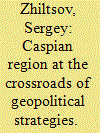| Srl | Item |
| 1 |
ID:
134116


|
|
|
|
|
| Publication |
2014.
|
| Summary/Abstract |
The author concentrates on the geopolitical games in the Caspian region and identifies the factors that have remained prominent in the last twenty years and, in fact, determined the developments in this part of the world, viz. oil and gas reserves, the scope of their industrial production, and the recently built export pipelines as geopolitical instruments of the Caspian states and extra-regional players.
He analyzes the geopolitical aims of Russia, the European Union, the U.S., and China, the key players responsible for the Caspian geopolitical context, to conclude that the region's geopolitical, social, economic, and political future, as well as its interstate relations largely depend on the pace at which oil and gas is produced and pipeline projects implemented
|
|
|
|
|
|
|
|
|
|
|
|
|
|
|
|
| 2 |
ID:
170450


|
|
|
|
|
| Summary/Abstract |
This article offers a preliminary checklist for identifying the geopolitical motivations of decision makers responsible for major famines, events defined as economic and social crises causing one million or more excess deaths. Three geopolitical motivations are identified in three major famines in the twentieth century. The 1932–1933 Ukrainian famine illustrates the strategy of starving a geographically concentrated, politically distrusted minority into submission and repopulating areas with politically trustworthy settlers and indoctrinated or assimilated traumatized famine survivors. The 1943 Bengal famine illustrates the starvation of politically distrusted populations in areas likely to be lost to invasion to make consolidation of that conquest expensive and to impede further conquest. The 1994–1995 North Korean famine illustrates the starvation of population in areas that pose a lesser risk of catastrophic regime delegitimation. Given the near certain decrease in grain production and probable declines in livestock production and fish catch in the Global South anticipated with climate change, decision makers are likely to be tempted to execute major famines to realize these geopolitical objectives. The geopolitical advantage from major famine thus merits the attention of famine-studies scholars.
|
|
|
|
|
|
|
|
|
|
|
|
|
|
|
|